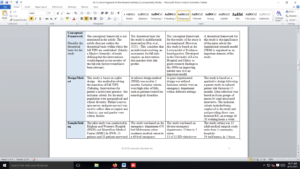o Prepare:
- Reflect on the four peer-reviewed articles you selected in Module 2 and the four systematic reviews (or other filtered high- level evidence) you selected in Module 3.
- Reflect on the four peer-reviewed articles you selected in Module 2 and analyzed in Module 3.
- Review and download the Critical Appraisal Tool Worksheet Template provided in the Resources.
The Assignment (Evidence-Based Project)
Part 3A: Critical Appraisal of Research
Conduct a critical appraisal of the four peer-reviewed articles you selected by completing the Evaluation Table within the Critical Appraisal Tool Worksheet Template. Choose a total of four peer- reviewed articles that you selected related to your clinical topic of interest in Module 2 and Module 3.
Note: You can choose any combination of articles from Modules 2 and 3 for your Critical Appraisal. For example, you may choose two unfiltered research articles from Module 2 and two filtered research articles (systematic reviews) from Module 3 or one article from Module 2 and three articles from Module 3. You can choose any combination of articles from the prior Module Assignments as long as both modules and types of studies are represented.
Part 3B: Critical Appraisal of Research
Based on your appraisal, in a 1-2-page critical appraisal, suggest a best practice that emerges from the research you reviewed. Briefly explain the best practice, justifying your proposal with APA citations of the research.
My Clinical Issues (PICO(T)) Q is:
- A PICOT on fall prevention is developed as follows:
- P(population)- Inpatient adults 40 years and above
- I(intervention) –A rigorous assessment and early ambulation
- C(Comparison)- Bed alarms and fall education
- O(Outcome)- Fall reduction in the Telemetry and Medical-Surgical floors
- T(Time)- During the hospital stay
Please look over rubric. APA format. This is the four articles to be appraise:
- Cuevas-Trisan, R. (2019). Balance problems and fall risks in the elderly. Clinics in Geriatric Medicine, 35(2), 173-183. https://doi.org/10.1016/j.
cger.2019.01.008 - Pop, H., Lamb, K., Livesay, S., Altman, P., Sanchez, A., & Nora, M. E. (2020). Tailoring a comprehensive bundled intervention for ED fall prevention. Journal of Emergency Nursing, 46(2), 225-232.e3. https://doi.org/10.1016/j.jen.
2019.11.010 - Wilson, D. S., Montie, M., Conlon, P., Reynolds, M., Ripley, R., & Titler, M. G. (2016). Nurses’ perceptions of implementing fall prevention interventions to mitigate patient-specific fall risk factors. Western Journal of Nursing Research, 38(8), 1012-1034. https://doi.org/10.1177/
0193945916644995 McCarty, C. A., Woehrle, T. A., Waring, S. C., Taran, A. M., & Kitch, L. A. (2018). Implementation of the MEDFRAT to promote quality care and decrease falls in community hospital emergency rooms. Journal of Emergency Nursing, 44(3), 280-284. https://doi.org/10.1016/j.jen. 2017.10.007 - Yeh, T., Chang, Y., Hsu, Y., Huang, L., Yang, C. (2020).Causes of nursing staff burnout: Exploring the effects of emotional exhaustion, work–family conflict, and supervisor support. Journal of Nursing Science https://doi.org/10.1111/jjns.
12392
template is attached . One is a rubric the other is the worksheet
Answer preview
The pilot study was conducted in Brigham and Women’s Hospital (BWH) and Montefiore Medical Center (MMC).In BWH, 31 patients and 33 patients answered pre-survey and post surveys respectively-females(60%), 55 years and above (53%), Caucasian(66%). In MMC, 32 patients answered pre-survey, and 30 post-surveys-females (68%), 55 years and above (53%), African American (53%), Latino (32%).
The study was based on the emergency department-676 bed Midwestern urban academic medical center in a 60-bed emergency department unit. Pediatric and adult populations (approximately 74000 per year)
Intervention team: 5 registered nurses (1-12 years ED experience); 4 nurse aids (1-3 years ED experience); 1 nurse doctoral project; 2 doctoral prepared faculty members.
The study was based on diverse emergency departments.-12sites in 3 states. 11 of 12 ED visited over four months- Attended by 60 nurses.
The study setting was 13 adult medical surgical study units from 3 community hospitals. 34 staff nurses, in 5 focus groups (6-7 nurses).
Females (92.1%), White (92.1%), worked full-time (92.1%), day shift (72.1%), baccalaureate degree (44.7%), associate degree/diploma (42.1%).
[2278 Words]
